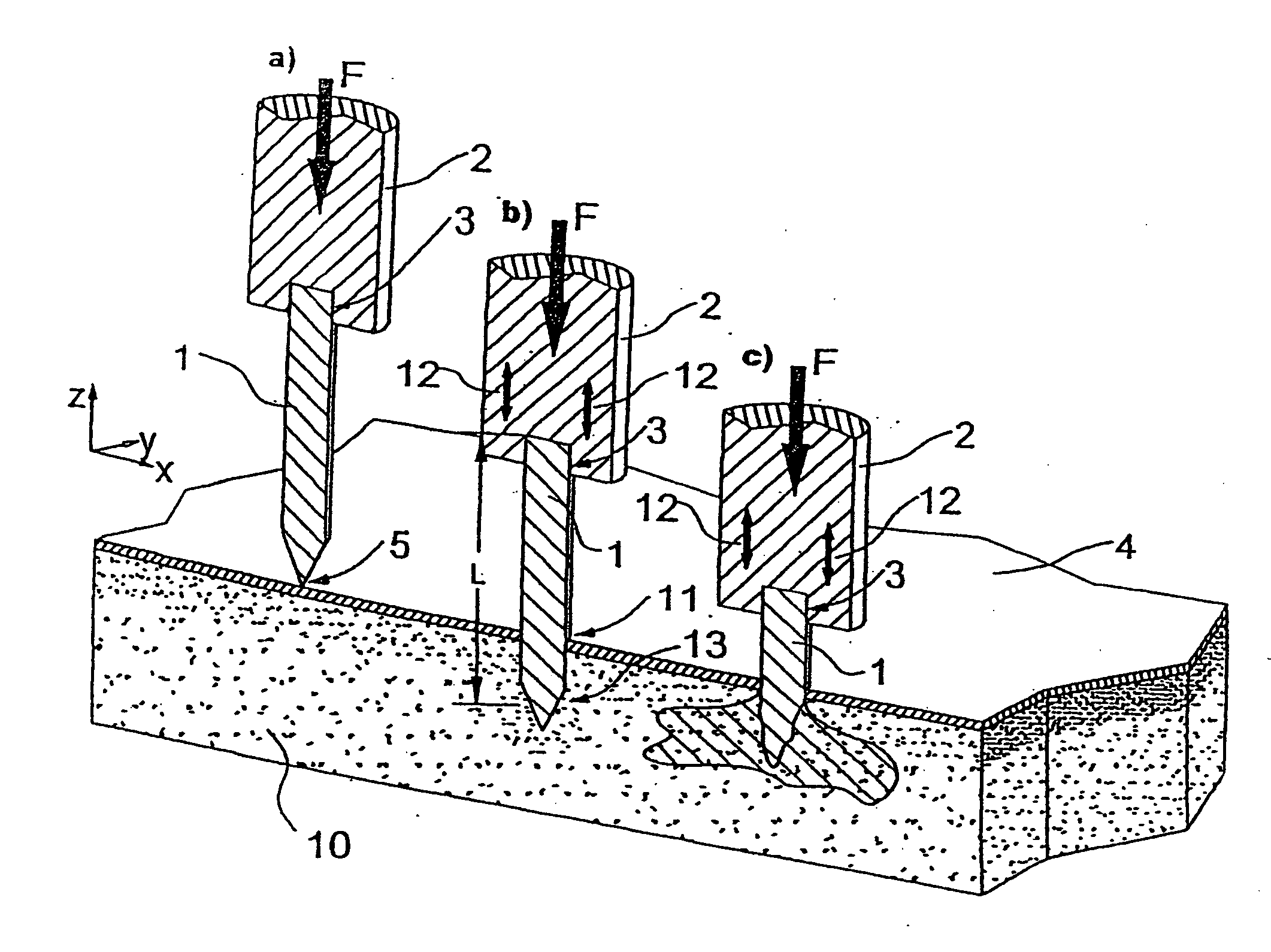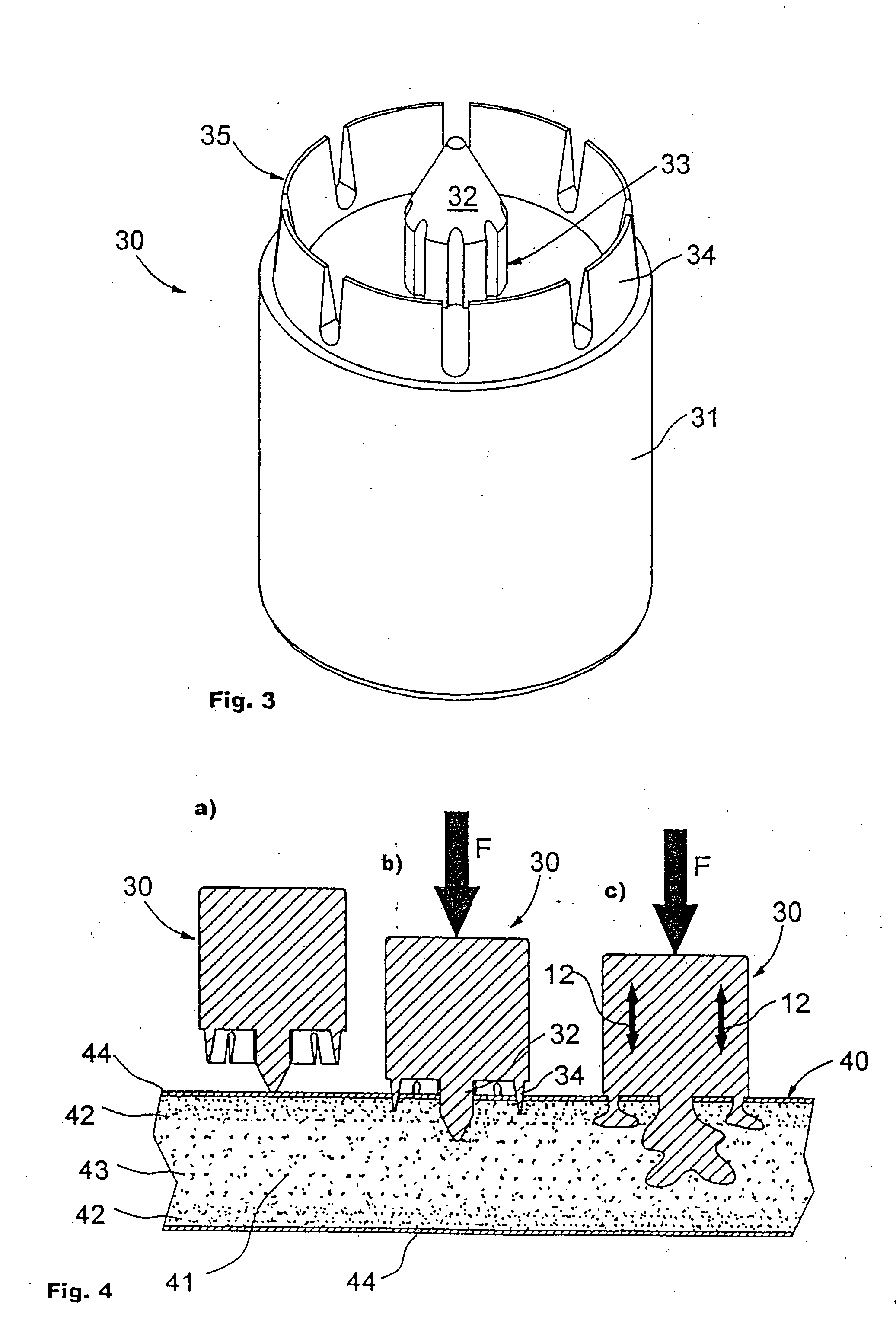[0013] An object of the present invention discussed is a method by means of which joints between bodies can be economically manufactured, wherein harmful stress concentrations are avoided and an optimum introduction of the load is achieved even in extremely porous materials.
[0016] As a result of the mechanical pressing in of the joining element, a material compression of the base material results, which has an advantageous effect on the strength. Under normal circumstances, the stress peaks produced by the displaced and compressed material would lead to a
cracking of the material. By the purpose-specific and matched application of
ultrasound and external
mechanical pressure, as well as by the designing of the joining elements according to the invention, however, the stresses produced are degraded and a destruction of the elements to be joined does not take place. Cavities and cracks produced nonetheless are immediately filled by the
molten material. The invention disclosed here, for this reason for the first time makes it possible to anchor fixing elements in a single working step in materials and in particular in porous material such as wood,
pressboard boards or cellular concrete and combinations of them with an in
depth effect and without any pre-drilling. Through the controlled material compression in areas within the adjacent zones, the joining elements achieve a very strong retention even in very porous materials. As a result, very high mechanical tear-out forces are obtained. By the additional spatial penetration of the compressed anchoring zone and of the adjacent zones with the
molten material of the joining element under
high pressure underneath the surface of the material, the compressed material of the anchoring is additionally consolidated. An optimum distribution of the introduced loads and a degrading of harmful stress peaks are therefore assured. Thus, for example, for the first time it is possible to implement durable and load-resistant anchoring points for load introduction points even in pressboards equipped with a
melamine layer without pre-drilling and in a single working step. By heat and pressure the wood is plastically deformed, the internal stresses are strongly reduced or equalized.
[0017] In contrast to prior art, the joining elements of the invention disclosed here do not only act in the surface zone of the elements to be joined, but preferably in their interior. Accordingly, a pre-drilling of all parts to be joined is not necessary, which has a positive effect in particular with respect to the economy of the process. It is further achieved that the anchoring points of the present invention, in contrast to those methods known from prior art, which call for a pre-drilling of the parts to be joined, are capable of being subjected to higher loads. Apart from this, the production of dust during the
processing procedure is avoided either wholly or to a great extent. As a result of the deliberate reduction of stress peaks generated in the base material, it is possible even in very thin elements to anchor very thick joining elements without pre-drilling. Experiments have demonstrated, that, for example, a joining element in accordance with the invention, which has a thickness of approximately 8 mm, without any pre-drilling is capable of being anchored in the
edge surface of a
pressboard board with a thickness of approximately 20 mm. The anchoring of load introduction or joining points in porous materials, therefore, is dramatically rationalized.
[0018] In further accordance with the present invention, since a pre-drilling of the parts is not required anymore or, if required, is integrated in the same step, for example, in that the joining element serves for the pre-drilling operation prior to the melting down, first of all time is saved, secondly expensive machines can be made do without and thirdly the otherwise high demands with respect to precision of the pre-drilling are reduced. With the method demonstrated here, for this reason parts can be joined in a similarly simple manner, as, e.g., by means of nailing: After the parts to be joined have been placed on top of one another, they are firmly joined in a single working step by means of a material and a positive
interlocking integral joint. In contrast to nailing, this joint, i.e., guarantees an optimum introduction of the forces into the parts to be joined.
[0020] The advantageous excitation of the joining elements by means of
ultrasound (or an equivalent means) creates a very high shear effect, particularly parallel to the main direction of joining, between the surfaces rubbed together. This, in turn, causes the materials destined to be melted down, which as a rule comprise
thermoplastic plastic materials, to become liquid, by means of which a
deep penetration into the parts to be joined is assured. This represents a significant
advantage in comparison to the methods known from prior art, which, for example, are based on friction by rotation (
friction welding) and which, therefore, have only a relatively low shear effect. In addition, during
friction welding a movement vertical to the
welding direction is generated, which as is known has a negative effect on the anchoring depth.
[0021] Advantageously, joining elements made of
thermoplastic plastic materials are utilized.
Thermoplastic plastic materials have a very high mechanical damping effect, which leads to an irreversible
energy absorption. Because of the poor
thermal conductivity of plastic materials, this
energy absorption becomes noticeable in particular in the case of components, which are excited with a
very high frequency (e.g.,
ultrasound), inasmuch as these melt down in an uncontrolled manner. Through an admixture of materials, which specifically control the mechanical damping, for the first time it is possible to avoid an uncontrolled melting down of the joining elements. In dependence of this, a higher
mechanical load bearing capacity of the joining elements is obtained during the
processing. In particular during the mechanical breaking through the covering
layers, one is able to achieve an enhanced robustness, which also has a secondary effect on the subsequent
mechanical load-
bearing capacity of the joining elements. Particularly advantageous are materials, such as
lime powder or wood dust, which have an isotropic characteristic, or other materials, such as reinforcing fibers, etc., which have an an-isotropic characteristic. Through the quantity of the additional material components, the characteristics of the joining elements can be specifically adjusted. The joining elements may also have a higher concentration of the additional material component in part or in zones. By means of this, the melting down zones can be controlled additionally.
 Login to View More
Login to View More 


